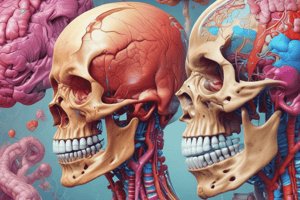Podcast
Questions and Answers
Which process is responsible for breaking down substances in the body and releasing energy?
Which process is responsible for breaking down substances in the body and releasing energy?
- Anabolism
- Metabolism
- Catabolism (correct)
- Homeostasis
Which of the following systems is responsible for transporting oxygen to cells?
Which of the following systems is responsible for transporting oxygen to cells?
- Circulatory System (correct)
- Nervous System
- Respiratory System
- Digestive System
Which of the following is NOT a function of the Integumentary system?
Which of the following is NOT a function of the Integumentary system?
- Sensation of touch
- Regulation of body temperature
- Production of blood cells (correct)
- Protection from the environment
Which anatomical term describes a structure that is closer to the midline of the body?
Which anatomical term describes a structure that is closer to the midline of the body?
Which organ system filters waste products from the blood and eliminates them as urine?
Which organ system filters waste products from the blood and eliminates them as urine?
Which body cavity houses the brain?
Which body cavity houses the brain?
Which of the following terms describes a cut that divides the body into anterior and posterior sections?
Which of the following terms describes a cut that divides the body into anterior and posterior sections?
What is the primary function of the endocrine system?
What is the primary function of the endocrine system?
Which of the following terms best describes the location of the skin in relation to the bones?
Which of the following terms best describes the location of the skin in relation to the bones?
Which of the following is an example of an anabolic process?
Which of the following is an example of an anabolic process?
Which system is responsible for providing support and structure to the body?
Which system is responsible for providing support and structure to the body?
What is the role of the lymphatic system in the body's defense system?
What is the role of the lymphatic system in the body's defense system?
Which directional term indicates a structure that is farther away from the point of attachment?
Which directional term indicates a structure that is farther away from the point of attachment?
Which organ system is responsible for coordinating body activities and transmitting impulses?
Which organ system is responsible for coordinating body activities and transmitting impulses?
Which anatomical plane divides the body into equal right and left halves?
Which anatomical plane divides the body into equal right and left halves?
Which of the following terms is used to describe the lining of a body cavity?
Which of the following terms is used to describe the lining of a body cavity?
Flashcards
Anatomy
Anatomy
The study of the structure of an organism.
Physiology
Physiology
The study of the function of the parts of an organism.
Metabolism
Metabolism
All of the chemical reactions in the body.
Anabolism
Anabolism
Signup and view all the flashcards
Catabolism
Catabolism
Signup and view all the flashcards
Integumentary System
Integumentary System
Signup and view all the flashcards
Digestive System
Digestive System
Signup and view all the flashcards
Circulatory System
Circulatory System
Signup and view all the flashcards
Integumentary
Integumentary
Signup and view all the flashcards
Skeletal
Skeletal
Signup and view all the flashcards
Anatomical Position
Anatomical Position
Signup and view all the flashcards
Superior
Superior
Signup and view all the flashcards
Proximal
Proximal
Signup and view all the flashcards
Visceral
Visceral
Signup and view all the flashcards
Sagittal Plane
Sagittal Plane
Signup and view all the flashcards
Dorsal Cavity
Dorsal Cavity
Signup and view all the flashcards
Study Notes
Human Anatomy and Physiology
- Anatomy is the study of the structure of an organism.
- Physiology is the study of the function of the parts of an organism.
- Organization in the human body: chemicals (non-living) → cells (living) → tissues → organs → systems → organism.
Organ Systems
- Integumentary System:
- Organs: Skin, hair, nails, sweat glands.
- Function: Covers body and regulates body temperature.
- Skeletal System:
- Organs: Bones.
- Function: Supports the body and protects organs.
- Muscular System:
- Organs: Muscles.
- Function: Movement.
- Nervous System:
- Organs: Spinal cord, brain, nerves.
- Function: Controls movement and the five senses.
- Digestive System:
- Organs: Stomach, mouth, intestines.
- Function: Gets nutrients and energy from food; eliminates solid waste.
- Circulatory (Cardiovascular) System:
- Organs: Heart, blood vessels, blood.
- Function: Carries oxygen to cells.
- Respiratory System:
- Organs: Lungs.
- Function: Gets oxygen into the body and carbon dioxide out.
- Endocrine System:
- Organs: Glands.
- Function: Regulates metabolism.
- Lymphatic System:
- Organs: Lymph nodes and vessels.
- Function: Helps get rid of disease.
- Excretory (Urinary) System:
- Organs: Kidneys.
- Function: Removes liquid waste (cleans nitrogenous waste from blood.)
- Reproductive System:
- Organs: Ovaries (female), testes (male).
- Function: Keeps species alive.
Life Processes
- Metabolism: All chemical reactions in the body, including:
- Anabolism: Building substances (requires energy). Example: healing a cut.
- Catabolism: Breaking down substances (releases energy). Example: digestion.
- Growth: Increase in cell size and number. Anabolism (building substances) must exceed catabolism (breaking down substances).
- Water: The human body is approximately 60% water.
- Homeostasis: Maintaining stable internal conditions in the body.
Anatomical Terms
- Anatomical Position: Body erect, facing forward, palms forward.
- Superior: Above (closer to the head).
- Inferior: Below (closer to the feet).
- Anterior (Ventral): Towards the front.
- Posterior (Dorsal): Towards the back.
- Medial: Towards the midline of the body.
- Lateral: Towards the sides of the body.
- Superficial: Towards the surface.
- Deep: Away from the surface.
- Proximal: Closer to the "body" (only on the same limb).
- Distal: Farther away from the "body" (only on the same limb).
- Visceral: Refers to internal organs.
- Parietal: Refers to the lining of body cavities.
Body Sections
- Sagittal: Lengthwise cut into right and left parts.
- Midsagittal: Lengthwise cut into equal right and left halves.
- Transverse: Horizontal cut into upper and lower parts.
- Frontal (Coronal): Cut into anterior and posterior parts.
Body Cavities
- Dorsal Cavity:
- Cranial Cavity: Contains the brain.
- Spinal Cavity: Contains the spinal cord.
- Ventral Cavity:
- Thoracic Cavity: Contains the heart and lungs.
- Abdominopelvic Cavity:
- Abdominal Cavity: Contains intestines, stomach, liver, etc.
- Pelvic Cavity: Contains excretory and reproductive organs.
Studying That Suits You
Use AI to generate personalized quizzes and flashcards to suit your learning preferences.





